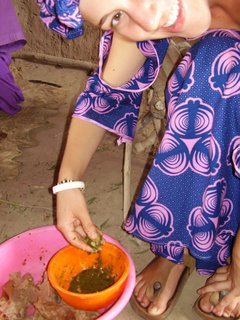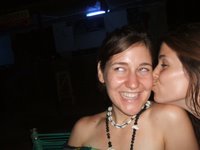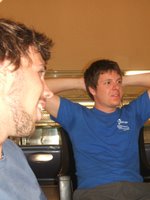Welcome to Sikasso Beach (now don’t be fooled, there is no such thing as a beach in Mali!)
The time has now come for me to describe my “new” surroundings. Okay, perhaps they are not so new anymore, since it may have been over a month since I moved here... But between a little bit of malaria (please note: there is no such thing as a little bit of malaria), a 5-day escape to Ségou, another 5-day escape in one of our vitamin villages and absolutely no days off in between, I have had problems finding the time or simply accessing a computer to update my blog. The MFP project has still not received the 2006 funds necessary to start up the activities in the different regions of Mali. Which means that the Sikasso office physically exists, with computers, printers, photocopiers, a conference room and everything Diallo and I could possibly dream of to keep the show on the road but... the power was turned off long ago because the bills were not paid!
Ahhhh! So we simply do without, going around harassing Diallo’s (rich!) family in the area. Yet again another reason to be thankful for the extended family concept in Mali. Uncles and aunts are doctors or owners of large, prosperous companies. Diallo is also somehow related to one of the two notaries in Sikasso (for a total of less than 40 in the country, to give you an idea of how special that makes him). So I am actually writing this from the notary office. Mohamed has kindly granted me the use of a computer for two days while Diallo took the 8-hour bus ride back to Sévaré to pick up his cheque.
Thinking back now to life in Sévaré, Sikasso feels like a different country altogether. First of all, when I first moved to Sikasso in a packed, old, decorated school bus in the middle of the night, I was woken up by some intense shivers running through my body. And it wasn’t even malaria (yet)!!! It was simply air: the suffocation was over. The wind entering the bus no longer made you feel like you were standing in front of a massive hair dryer. I had reached heaven. I don’t even know how I had managed to fall asleep in the first place. Our bus driver, apparently exhausted, had been driving in a giant slalom across the paved road while the front passengers, sitting right next to me, had been taking turns yelling to keep him awake. They were holding on for dear life and that of forty oblivious others who had long left for a few hours in the arms of Morpheus. Our time had not yet come, so the three prayer stops we made along the way must have paid off (I suspect what they were praying for), because we made it in one piece.
Within a week of my arrival in Sikasso, I moved in with the family of one of Keïta’s wives. Keïta is one of the technicians at the MFP Sikasso office. There was enough space for a bed in the servant’s bedroom, so I moved in with her. She is a lovely young Peul lady also named Awa. Like the majority of the other Peul women, she has the characteritic black permanent tatoo surrounding her mouth, numerous earrings and a thin, elegant silhouette. We got along immediately, though we couldn’t understand very much of each other. If a picture is worth a thousand words, gestures, I believe, are worth much more! Here is a bad picture of us in our room.

The yard was very lively, full of adorable children with their typical screams, cries and giggles. It seems as though one of the little girls, Mariam, made it her objective to become more reliable than my shadow. From experience, I know that these little girls are the key to fast integration in a family, so I very much appreciated her company. But I left for a few days to go to my mid-placement retreat in the Pays Dogon, and I came back to a nearly empty yard. The kids had gone to Bamako to spend the summer with their cousins and grand-parents. No need to say that I was quite disappointed. From what I can tell this is a popular move in rich families that do not depend on agriculture. In farming families, the reverse phenomenon is true: all their children come back from the cities to go lend a hand in the family fields. Some had originally left after harvest to go to school in the city, if they could afford it. The less fortunate had gone in an attempt to find employment.
One thing that strikes me about Sikasso is the absence of in-your-face extreme poverty on the side of the roads. As opposed to Sévaré, I saw no women bathing in roadside puddles after the rain. People here greet me with regular salutations rather than a difficult “Donne-moi 100 francs!”. The streets are not filled with young children pleading for food destined to their marabou in their tomato cans recycled in buckets. You never have to run for cover because of a sandstorm, but instead you better watch out for an unannounced downpour. There is maïze everywhere you look! It is tall, green, strong and has nothing to do with the large, dry fields of Sévaré, where it was difficult for me to imagine anything ever growing...
Hence tô and baga are both made of maïze here, rather than the drought resisting cereal (mil, I don’t really know what that translates to) used in Sévaré, which makes it much more pleasant to eat. Baga is a basically corn flour and water. Rich families, or in poor families the head of the household, add milk powder and sugar. I couldn’t tell if it was the colour, the actual taste of the cereal, or some particular spice that perhaps everybody uses that made me gag in most (all?) Sévaré traditional meals... But those days are over, since I have been pleased with any and every thing that found its way to my stomach since I made it here. My stomach and and my tastebuds still disagree, though, and it looks as though I will have to deal with a “ventre qui coule” until my return to Canada. And according to past EWB volunteers and past experience after my return from Peru, it’s not as simple as walking off the plane and your tummy bugs (bacteria, amoebas, worms?) are gone. They have a frustrating tendency to overstay their welcome...
Mmmm... tô!









